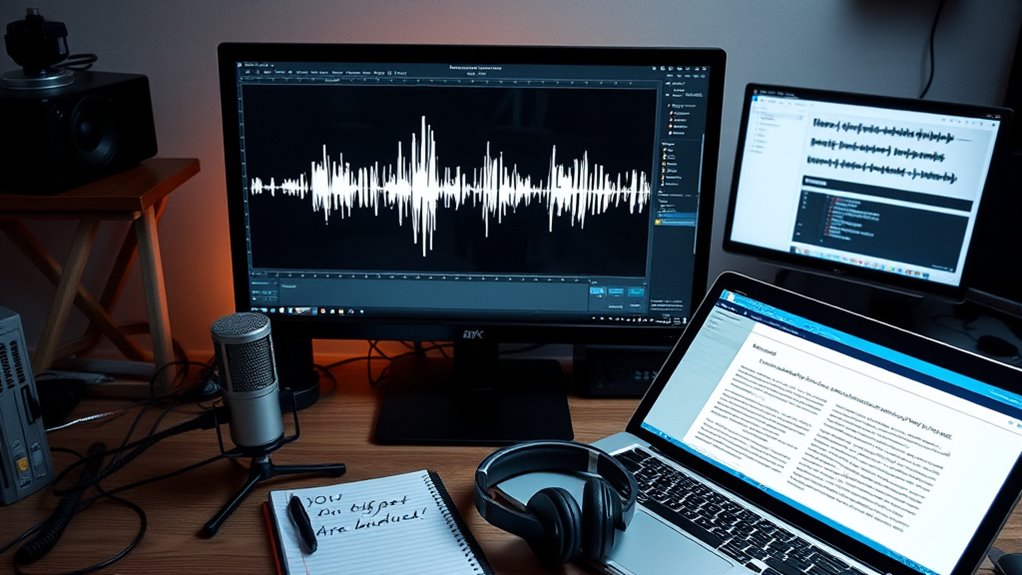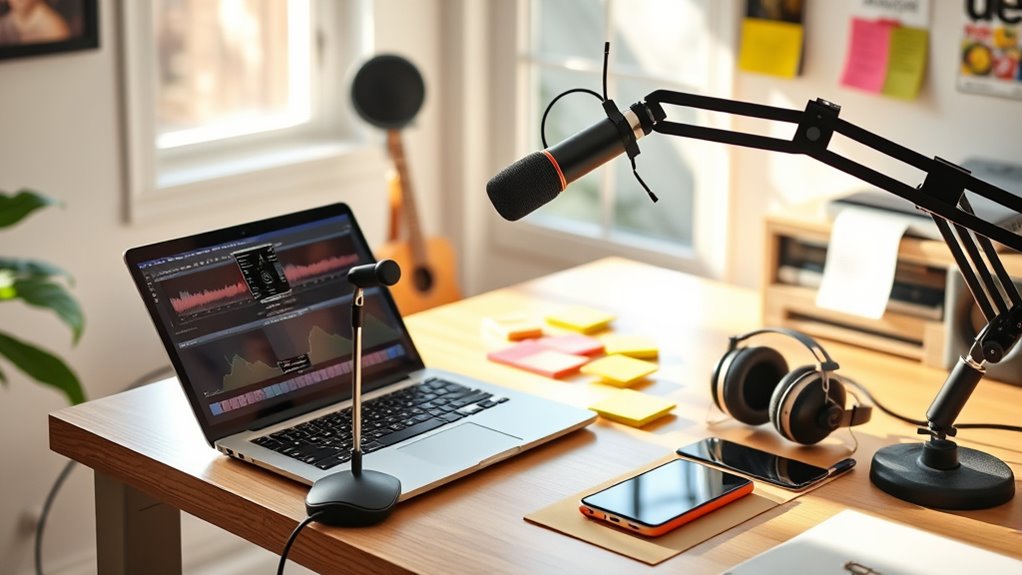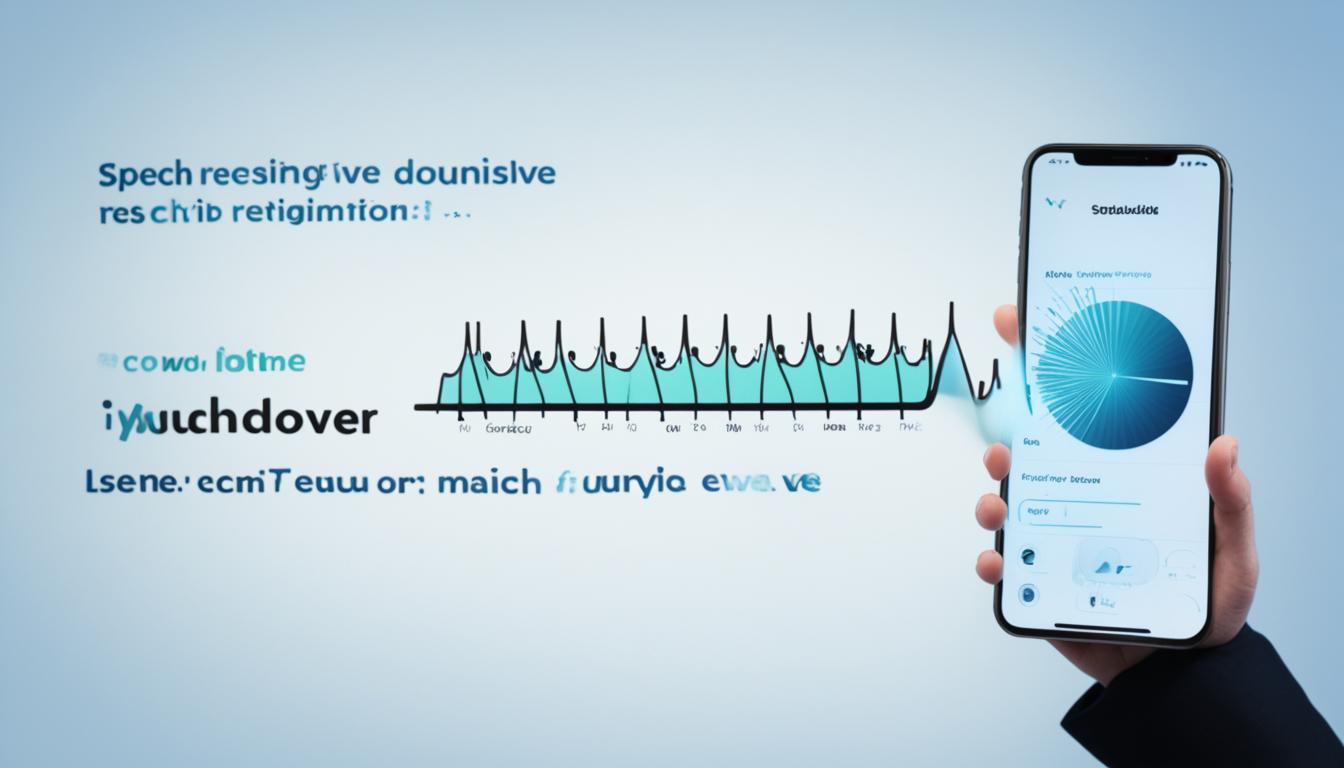To caption your podcast on a budget, choose affordable tools like free or low-cost transcription software that balances accuracy and features. Start by recording with clear audio to simplify transcribing, then use free editors like Subtitle Edit or Aegisub for syncing captions with your audio. Edit for accuracy, consistency, and proper formatting. Finally, upload your captions in compatible formats and promote your episodes. If you keep following these steps, you’ll discover effective ways to create professional captions without overspending.
Key Takeaways
- Choose affordable, user-friendly transcription tools with automatic speech recognition, like Otter.ai or Descript’s free tier.
- Record high-quality audio by minimizing background noise and speaking clearly to improve transcription accuracy.
- Use free editing software such as Subtitle Edit or Aegisub to synchronize captions precisely with audio.
- Review and manually correct automated transcripts for accuracy, ensuring proper formatting and timing.
- Export captions in compatible formats (SRT, VTT) and upload them to hosting platforms, promoting accessibility at low cost.
Choosing Affordable Tools for Captioning

When you’re on a tight budget, choosing the right captioning tools can make a big difference. Look for cost-effective software that offers essential features without breaking the bank. Many budget-friendly services provide accurate automatic transcription, making it easier to create captions quickly and affordably. You don’t need the most expensive options; instead, focus on tools that balance quality and affordability. Free or low-cost software often includes helpful integrations and user-friendly interfaces, helping you maintain a professional look without extra costs. By selecting these budget-conscious options, you guarantee your podcast remains accessible while staying within your financial limits. Remember, the goal is to find reliable captioning tools that deliver good results without overspending, making your workflow more efficient and cost-effective. Additionally, exploring affordable anime movies can provide inspiration for engaging content that resonates with your audience.
Transcribing Your Podcast Content Efficiently

Once you’ve selected affordable captioning tools, the next step is to transcribe your podcast content efficiently. To guarantee good caption accuracy, start with high audio quality, as clear recordings reduce errors during transcription. Speak clearly and minimize background noise before recording. When transcribing, choose tools that support speech recognition and allow easy manual corrections. Review automated transcriptions carefully, correcting any inaccuracies to improve caption quality. Break down long segments into smaller parts for better accuracy. Keep your transcripts organized and timestamped, which helps streamline the editing process later. Prioritizing audio clarity from the start saves time and ensures your captions are precise, making your content more accessible and professional without stretching your budget. Additionally, understanding the value of home security systems can help you protect your recording equipment and studio space from theft or vandalism, ensuring uninterrupted workflow.
Synchronizing Captions With Audio

Synchronizing captions with your podcast audio is essential for ensuring viewers can easily follow along. Proper caption timing depends on accurate audio alignment, so your captions appear at the right moments. To do this, listen to your podcast and identify key points where captions should start and end. Use free tools like Aegisub or Subtitle Edit to adjust caption timing precisely. When syncing, focus on syncing captions to the actual speech rather than the background sounds, unless necessary. Consistent audio alignment guarantees that captions match spoken words, reducing confusion. Take your time fine-tuning caption timing, as even small adjustments improve overall accessibility. Additionally, understanding how contrast ratio affects image quality can help you create a more visually engaging presentation. Accurate synchronization makes your podcast more professional and accessible to all audiences.
Editing and Formatting Your Captions for Accuracy

To guarantee your captions are clear and reliable, you need to carefully edit and format them for accuracy. Start by reviewing the captions to ensure they match the audio clarity, catching any errors or misinterpretations. Pay attention to caption styling, such as consistent font, size, and line breaks, which improves readability. Correct misspellings, punctuation, and timing issues to make sure the captions sync perfectly with speech. Use short, simple sentences to enhance comprehension. Proper formatting helps viewers follow along easily, especially when audio quality varies. Remember, well-edited captions not only boost accessibility but also reflect professionalism. Taking the time to refine your captions ensures your audience receives an accurate, engaging, and enjoyable listening experience. Additionally, understanding the Kia Tuning options can inspire creative modifications, making your content more dynamic and personalized.
Publishing and Distributing Captioned Episodes

Publishing and distributing captioned episodes requires careful planning to guarantee your content reaches your audience effectively. First, verify your audio quality is clear before adding captions, as poor audio can reduce listener engagement. When uploading your episode, include captions in compatible formats like SRT or VTT, so they display correctly across platforms. Check that your hosting service supports caption files and that they sync properly with your audio. Promote your captioned episodes through social media and newsletters to boost visibility. Remember, well-distributed content with accurate captions enhances accessibility and audience engagement, making your podcast more inclusive. Consistently confirm that captions appear correctly on different devices, ensuring a seamless experience for all listeners. Proper publishing and distribution maximize your reach and foster a loyal audience. Additionally, consider vetted methods for ensuring your captions remain clear and comfortable for listeners, such as proper timing and text formatting.
Frequently Asked Questions
How Can I Ensure My Captions Are Accessible to All Listeners?
To make your captions accessible to all listeners, focus on improving transcription accuracy and caption formatting. You should double-check your transcriptions for errors and guarantee proper punctuation, speaker labels, and timing. Use clear, legible fonts and consistent formatting to enhance readability. By prioritizing accurate transcriptions and well-formatted captions, you’ll create an inclusive experience that benefits everyone, including those with hearing impairments or language barriers.
What Are Common Mistakes to Avoid in DIY Captioning Workflows?
Ever wondered what mistakes could ruin your captions? You should avoid poor caption timing and sloppy transcript formatting, which can confuse listeners and reduce accessibility. Do you check your captions for sync issues or typos? Skipping these checks leads to frustration and miscommunication. To stay on track, proofread, guarantee accurate timing, and follow consistent formatting. Keeping these in mind helps you create clear, professional captions effortlessly.
Which Free or Low-Cost Tools Offer the Best Accuracy?
When choosing free or low-cost tools for automatic transcription, look for options with high accuracy, like Otter.ai or Descript’s free plan. These platforms combine automatic transcription with editing software, making it easy to correct mistakes. You get a good balance of affordability and precision, helping you produce captions that are clear and professional without breaking the bank. Always review and edit transcripts to guarantee the best quality.
How Do I Handle Multiple Speakers in a Podcast Episode?
When handling multiple speakers, focus on speaker differentiation and audio segmentation to improve accuracy. Use tools like Otter.ai or Descript that automatically identify different voices and segment audio accordingly. Clearly label each speaker during editing to keep captions organized. You can also manually adjust segments if needed. This approach guarantees your captions accurately reflect who’s speaking, making your podcast more accessible and engaging for your audience.
What Are the Legal Considerations for Captioning Podcast Content?
Imagine you’re steering a maze of legal rules, like a knight in shining armor. When captioning your podcast, you must guarantee copyright compliance—using content legally—and address privacy concerns, especially with sensitive or personal info. Failing to do so could lead to legal trouble or privacy violations. Always obtain necessary permissions, credit sources properly, and be mindful of confidential details to keep your content safe and compliant.
Conclusion
By embracing these budget-friendly captioning workflows, you’re opening the door to a world where your podcast’s message flows seamlessly to all listeners. Think of it as planting seeds in a fertile field—each step nurtures accessibility and growth. With a little effort, you’ll cultivate episodes that resonate deeply, making your content a welcoming space for everyone. Keep refining your process, and watch your podcast bloom into a vibrant, inclusive community.











